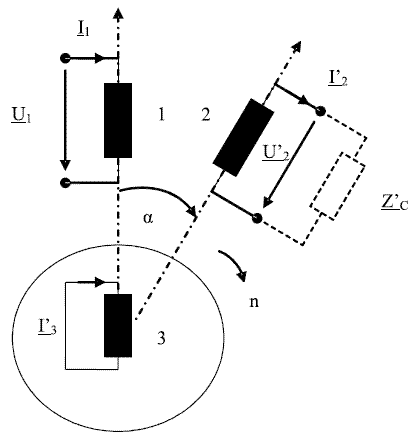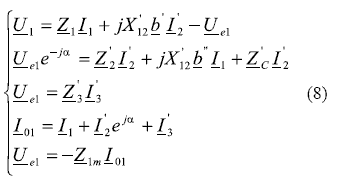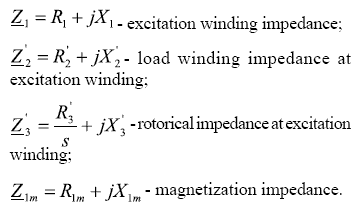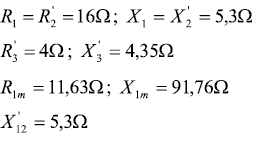Services on Demand
Journal
Article
Indicators
-
 Cited by SciELO
Cited by SciELO -
 Access statistics
Access statistics
Related links
-
 Cited by Google
Cited by Google -
 Similars in
SciELO
Similars in
SciELO -
 Similars in Google
Similars in Google
Share
Revista Facultad de Ingeniería Universidad de Antioquia
Print version ISSN 0120-6230On-line version ISSN 2422-2844
Rev.fac.ing.univ. Antioquia vol.38 no.1 Medellín Jan./Jun. 2006
The induction generator with two triphases windings in stator
Valentin Müller*
“Aurel Vlaicu” University of Arad, Engineering Faculty, Arad, Romania.
(Recibido el 24 de febrero de 2005. Aceptado el 15 de mayo de 2006)
Abstract
This paper shows the performance of an induction generator with two triphases windings in stator, and the choice of a suitable angle between the two windings in stator for getting a proper tension according to the value of the consumer connected at the generator terminals.
Key words : Induction generator, two triphases windings in stator, aero-electrical aggregates.
Generador de inducción con estator de dos envolvimientos trifásicos
Resumen
En el presente trabajo el autor ha estudiado el funcionamiento del generador de inducción con dos envolvimientos trifásicos en el estator, así como la elección adecuada del ángulo eléctrico entre los dos envolvimientos del estator para obtener una tensión correspondiente al valor del consumidor conectado a los bornes del generador.
Palabras clave: generador de inducción, dos envolvimientos trifásicos en el estator, agregados aire-eléctricos.
Introduction
This work refers to the production of the electrical energy using induction machines having in stator two triphases windings, the gap between them being the electrical angle α. We study here in influence of the gap α between the two windings on induction generator working and specially on the induction electromotor tension according to the value of the consumer connected at the generator terminals.
This work is connected with some previous researches on new electromechanical conversion systems of the energy using induction machines acting by the wind energy.
The choice of a rotor with two triphase windings determines opportunities in speed regulation of the induction machines for the desire purpose [1]. The analysis of the induction generator working is made for the gap between windings of α = 0o, α= 90o and α = 180o.
The mathematical model of the induction generator with two windings in stator
We use a triphase induction machine with two system of triphase windings placed symmetrical in rotor. The space gap is electrical angle α, and the rotor is in cage type. The first winding in stator (1) is considered to be excitation winding and the machine gets reactive power, the second winding triphase stator (2) is the load winding, at its terminals is connected the consumer, and the third winding (3) is the rotorical winding in cage type.
Figure 1 shows the sketch of an induction machine with two windings in stator.
Figure 1 Induction generator with two winding in stator
The induction generator gets mechanical power at the arbor and releases electrical power at the terminals, the slide of the machine s is negative.
For writing the equations which defined the generator working in steady regime, [2], [3], the load winding and the rotorical winding are dealing at the excitation winding. The parameters reported at the excitation winding are noted with (`).
In this equations the reactance X`12 , of mutual spread between the excitation winding and load winding is taken in consideration, [4].
For the excitation winding and the load winding we can write the next equations:where:
The equations for the rotorical winding – cage type, is: The total current of the machine reduced at stator is:
and the electromotor tension induced in excitation winding is:
The electromotor tensions induced in load winding and in rotorical winding at the electromotor tension induced in excitation winding, are:Therefore, a system of five equations, which determine, the function, of the induction generator with two triphases windings in stator is obtained:
With the notation:the current in the excitation winding: the current in the load winding: the current in the rotorical winding: the total current of the machine: the electromotor tension induced in the excitation winding:
The electrical parameters in relations (1) ÷ (5) are the next:
The electrical parameters which are reported at the excitation winding are determined by the next relations:
where:N1, N2, N3 - the number of whirl in excitation, load and rotorical winding;
Kb1, Kb2, Kb3- the winding factors corresponding to the three windings;
m1,m3- the number of phases in excitation winding and rotorical winding.
Application – a study of case
For an induction triphase machine with two windings in stator with PN = 1,5 kW, to 1500 rot/min, supply at UN = 380 V and f = 50 Hz, we have the next electrical parameters:
The theoretical results which were obtained at different gap α between the two windings in stator and the value of the consumer connected at the terminals of windings (2) are shown in tables 1, 2 and 3.
Table 1 The results for =α 0o
Table 2 The results for α = 90o
Table 3 The result for α = 180o
These results were obtained for a nominal slip of the machine s = -0,0193 in generator regime.
Conclusion
The electromotor tension decreases, concerning with the charge, of 16,85% for α = 0o, of 15,57% for α = 90o and only of 2,55% for α = 180o.
Therefore the best windings this dispersal in stator is α = 180o.
Such an electrical power system can be successfully used in isolated areas of the country at the power system, are in parallel with the power system for low and medium power.
References
1. N. Budisan. Problems of induction generator systems. The Polytechnic Editor. Timisoara. 2003. pp. 11-28. [ Links ]
2. T. Dordea. Electrical machines. The ASAB Editor. Bucharest. 2002. pp. 256-266. [ Links ]
3. S. Murthy. O. Malik. “Analysis of Self-Excited Induction Generators”. Proc, IEE Pt. Vol. 129. 1982. pp. 260-265. [ Links ]
4. A. Campeanu. Electrical machines. The Polytechnic Editor. Timisoara. 1999. pp. 305-313. [ Links ]







































